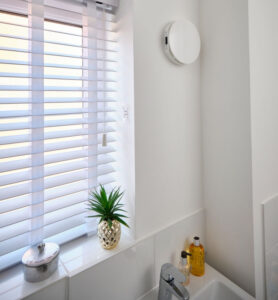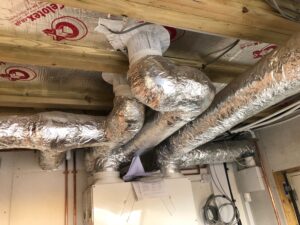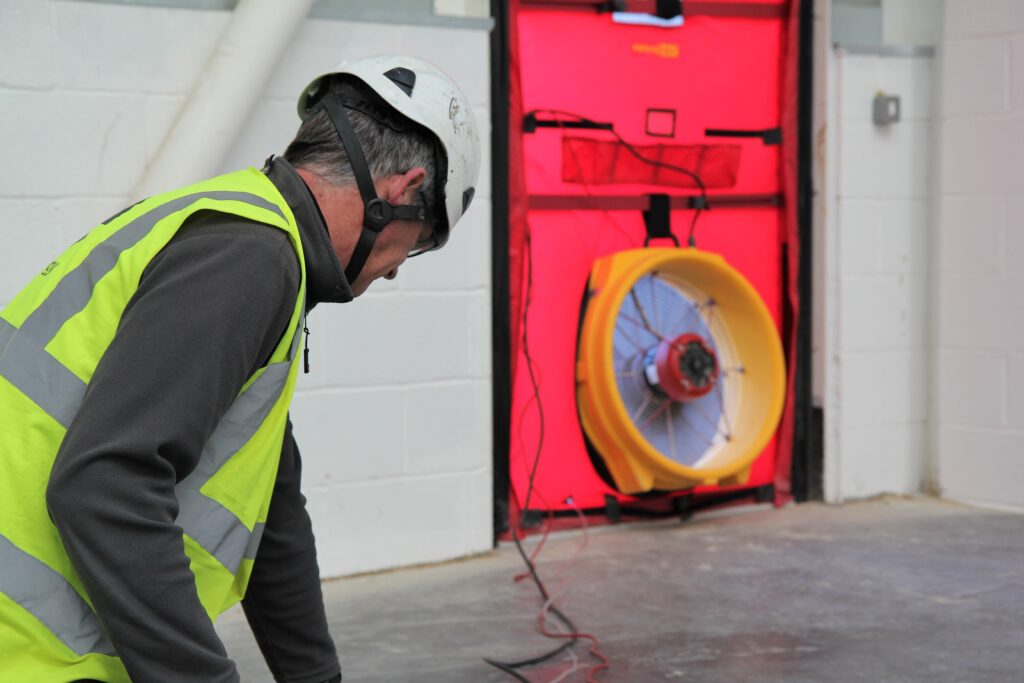Building airtightness is a key element of energy efficient construction. A well-sealed building minimises heat loss, reducing energy consumption and lowering utility bills.
However, achieving airtightness also necessitates an effective ventilation system to maintain indoor air quality. This article explains how the choice of ventilation system can maximize an airtight building envelope and help designers make informed decisions.
Understanding Ventilation Systems
Two common types of ventilation systems are Decentralised Mechanical Extract Ventilation (dMEV) and Mechanical Ventilation with Heat Recovery (MVHR). Both systems have unique characteristics and benefits, but their impacts on energy consumption, emissions, indoor air quality, and overall efficiency can vary significantly.
Decentralised Mechanical Extract Ventilation (dMEV)

dMEV extract
How it works
dMEV systems consist of individual extract fans installed in various rooms, typically in wet rooms like kitchens and bathrooms. These fans continuously remove stale air from the property.
Advantages
- Simple to install
- Low initial cost
- Suitable for retrofitting in existing buildings
Disadvantages
- Does not recover heat from extracted air, leading to potential heat loss and higher energy consumption
Mechanical Ventilation with Heat Recovery (MVHR)
How it Works
MVHR systems use a central unit to extract stale air and supply fresh air throughout the building. Importantly, they recover heat from the outgoing air and transfer it to the incoming air, thus reducing heat loss.
Advantages

An MVHR system
- Highly efficient in maintaining indoor air quality
- Significantly reduces heating demand
- Improves overall energy efficiency
Disadvantages
- Higher initial cost
- More complex installation process
- Often better suited for new builds or major renovations
Key findings within SAP on building airtightness and ventilation
We carried out some analysis of recent projects where we carried out SAP Calculations – these are used to demonstrate the energy performance of homes against UK building regulations. SAP Assessments provide a yardstick for how technologies affect building performance, at least in theoretical terms (that’s another topic!). The full table can be found below.
Comparing dMEV and MVHR systems
We compared dMEV and MVHR systems across various performance metrics in three levels of building airtightness: Airtightness of 1m³/h/m² (most airtight), 3m³/h/m², and 5m³/h/m² (least airtight). Here are the key findings:
Primary Energy Rate
- MVHR systems consistently showed better performance in reducing the primary energy rate.
- In AT5 (least airtight), the primary energy rate dropped by 14% with MVHR compared to dMEV.
- In AT1 (most airtight), there was a 23% reduction.
- The improvement from dMEV to MVHR ranged from 0.4% to 10.47%, indicating substantial energy savings with MVHR systems.
Emissions Energy Rate
- MVHR systems outperformed dMEV in reducing emissions.
- AT5 saw a 14% reduction, while AT1 experienced a 23% decrease in emissions energy rate with MVHR.
- Improvement rates varied from 0.2% to 10.75%, demonstrating the environmental benefits of using MVHR systems.
Fabric Energy Efficiency
- Both dMEV and MVHR systems showed no difference in fabric energy efficiency across all levels of airtightness, with improvement percentages being negligible.
- This suggests that while ventilation systems impact energy rates and emissions, the fabric efficiency remains largely unaffected by the choice of ventilation system.
SAP EPC Rating
- MVHR systems improved the SAP EPC ratings by 4% in AT5, 5% in AT3, and 6% in AT1.
- The overall improvement ranged from 1.22% to 2.47%, highlighting better energy performance with MVHR systems.
SAP 10.2 Space Heating Demand
- MVHR significantly reduced space heating demand, especially in more airtight buildings.
- AT1 saw a 34% reduction in space heating demand with MVHR.
- Improvement varied from 12% to 25.58%, underscoring the efficiency of MVHR systems in managing heating demands.
Indoor Air Quality
- MVHR systems excel in improving indoor air quality by continuously supplying fresh air while extracting stale air.
- This is particularly crucial in highly airtight buildings (AT1) where natural ventilation is minimal.
- Improved indoor air quality helps reduce allergens, pollutants, and humidity levels, creating a healthier living environment.
Primary Energy Rate
| Airtightness Level | dMEV(kWh/m²/yr) | MVHR (kWh/m²/yr) | MVHR Improvement |
|---|---|---|---|
| APT5 | 45.70 | 39.17 | 14% |
| APT3 | 45.54 | 37.19 | 18% |
| APT1 | 45.54 | 35.07 | 23% |
| APT 5-3 Improvement | 0.4% | 5.05% | |
| APT 3-1 Improvement | 0.0% | 5.70% | |
| APT 5-1 Improvement | 0.4% | 10.47% |
Emissions Energy Rate
| Airtightness Level | dMEV (kWh/m²/yr) | MVHR (kWh/m²/yr) | MVHR Improvement |
|---|---|---|---|
| APT5 | 4.33 | 3.72 | 14% |
| APT3 | 4.32 | 3.53 | 18% |
| APT1 | 4.32 | 3.32 | 23% |
| APT 5-3 Improvement | 0.2% | 5.11% | |
| APT 3-1 Improvement | 0.0% | 5.95% | |
| APT 5-1 Improvement | 0.2% | 10.75% |
Fabric Energy Efficiency
| Airtightness Level | dMEV (kWh/m²/yr) | MVHR (kWh/m²/yr) | MVHR Improvement |
|---|---|---|---|
| APT5 | 38.85 | 38.85 | 0% |
| APT3 | 37.76 | 37.76 | 0% |
| APT1 | 37.04 | 37.04 | 0% |
| APT 5-3 Improvement | 2.8% | 2.81% | |
| APT 3-1 Improvement | 1.9% | 1.91% | |
| APT 5-1 Improvement | 4.66% | 4.66% |
SAP EPC Rating
| Airtightness Level | dMEV (kWh/m²/yr) | MVHR (kWh/m²/yr) | MVHR Improvement |
|---|---|---|---|
| APT5 | 78 | 81 | 4% |
| APT3 | 78 | 82 | 5% |
| APT1 | 78 | 83 | 6% |
| APT 5-3 Improvement | 0.0% | 1.23% | |
| APT 3-1 Improvement | 0.0% | 1.22% | |
| APT 5-1 Improvement | 0.0% | 2.47% |
SAP 10.2 Space Heating Demand
| Airtightness Level | dMEV (kWh/m²/yr) | MVHR (kWh/m²/yr) | MVHR Improvement |
|---|---|---|---|
| APT5 | 2,033.74 | 1,798.12 | 12% |
| APT3 | 2,016.10 | 1,576.32 | 22% |
| APT1 | 2,016.10 | 1,338.22 | 34% |
| APT 5-3 Improvement | 0.9% | 12.34% | |
| APT 3-1 Improvement | 0.0% | 15.10% | |
| APT 5-1 Improvement | 0.9% | 25.58% |
What this means for building designers
For building designers, these findings underscore the importance of selecting the right ventilation system to enhance building airtightness, energy performance, and indoor air quality. MVHR systems, while potentially more expensive upfront, offer significant long-term benefits in energy savings, reduced emissions, and improved EPC ratings. The more airtight the building, the more pronounced these benefits become, including superior indoor air quality.
Simplifying the concept
For customers not technically minded, think of it this way: a well-chosen ventilation system is like upgrading from a basic fan to a smart, energy-efficient air conditioning unit that also purifies the air. The smart system (MVHR) not only provides better air quality but also saves energy and reduces your heating bills. This means lower running costs, a healthier living environment, and a more environmentally friendly home. The tighter your home is sealed, the more you benefit from this advanced system.
Conclusion
In conclusion, the choice between dMEV and MVHR can have a substantial impact on a building’s energy efficiency, environmental footprint, and indoor air quality. MVHR systems generally offer superior performance, making them a preferable choice for new builds and renovations aimed at achieving high energy efficiency standards, particularly in more airtight buildings.
At BE, we are committed to providing you with the best insights and solutions for your building projects. If you have any questions or need further advice on selecting the right ventilation system, please do not hesitate to contact us.

